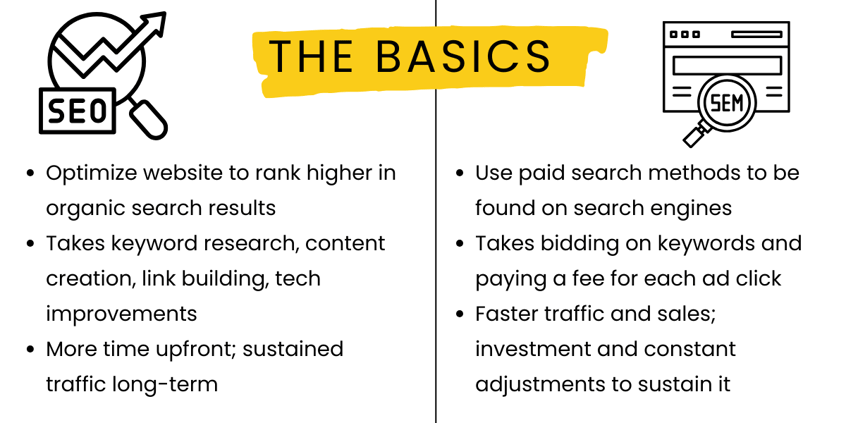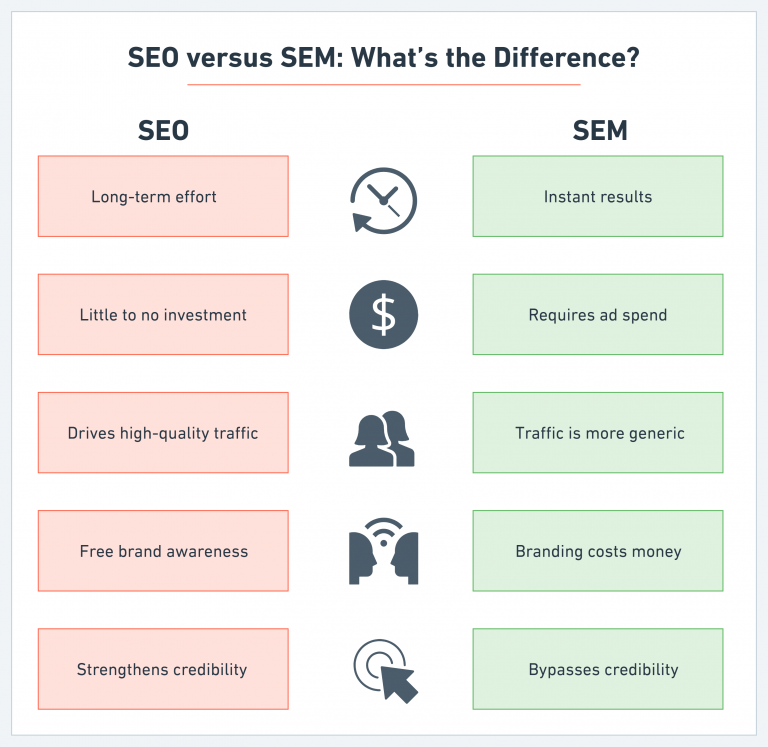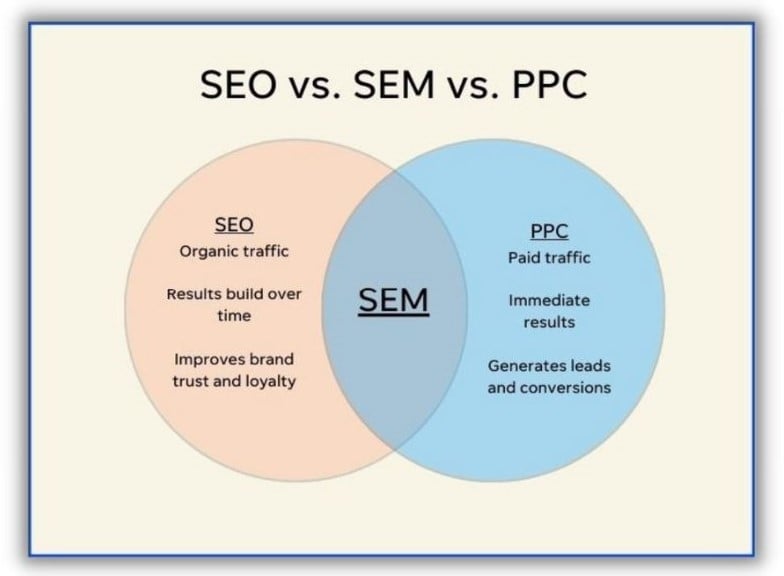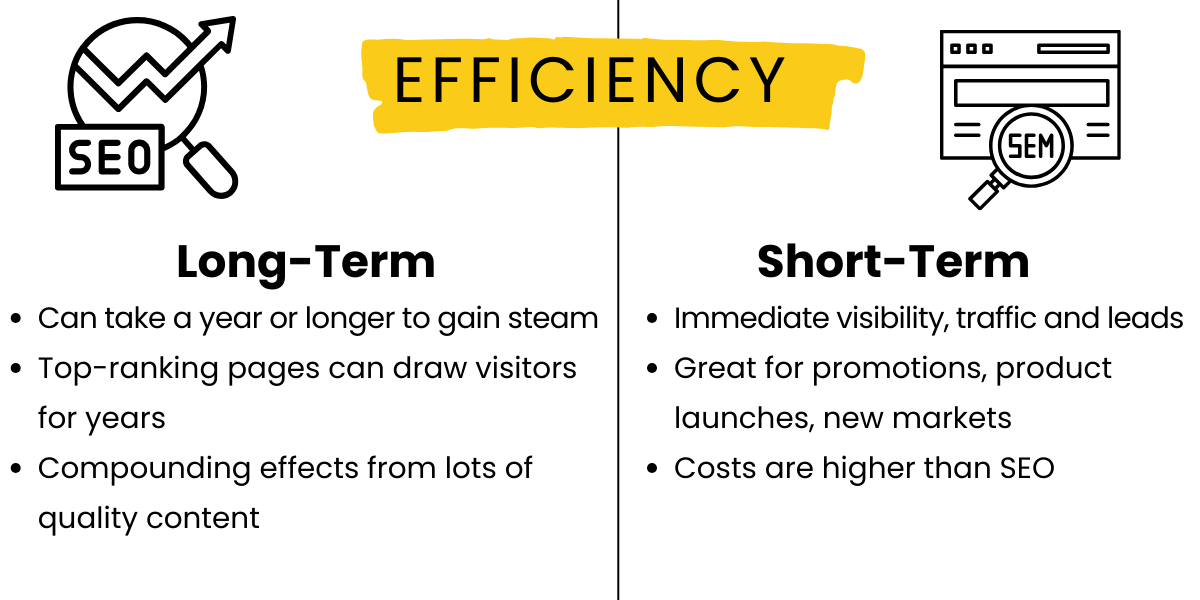Unleash the power of digital marketing with our comprehensive guide to SEO vs SEM – knowledge is key!

Image courtesy of via DALL-E 3
Table of Contents
Introduction to SEO and SEM
In this section, we’ll introduce readers to SEO and SEM. We’ll explain what these terms mean and why they are important in online marketing.
What are SEO and SEM?
SEO stands for Search Engine Optimization. It’s all about making your website rank higher on search engines like Google so that more people can find it. SEM, on the other hand, stands for Search Engine Marketing. It involves using paid strategies like ads to increase your website’s visibility. So, SEO is about improving your site’s ranking organically, while SEM involves paying to get your site seen.
Why are they important?
SEO and SEM are crucial in the world of online marketing because they help make websites more visible on search engines. When people search for something online, they usually click on the first few results that show up. By using SEO and SEM strategies, businesses can ensure that their websites appear at the top of search results, attracting more visitors and potential customers.
Basics of SEO
SEO stands for Search Engine Optimization. It’s like a secret code that helps websites show up when you search for something online. Imagine it as a map that guides you to the coolest hidden treasure on the internet!
How Does SEO Work?
SEO works by using special words called keywords that match what people are searching for. When a website has the right keywords, search engines like Google think it’s super helpful and show it to more people. Plus, the quality of the website and how fast it loads also matter for SEO. It’s like having a super cool treehouse that everyone wants to visit because it’s awesome and easy to find!
Basics of SEM
SEM, which stands for Search Engine Marketing, is a digital marketing strategy that involves paying for ads to appear in search engine results. These ads are typically labeled as such and can be seen at the top or bottom of search results pages. SEM is a way for businesses to promote their websites by increasing their visibility on search engines through paid advertising.

Image courtesy of thezoeteam.com via Google Images
How Does SEM Work?
SEM works by bidding on specific keywords that potential customers are likely to use when searching for products or services online. When a user enters those keywords into a search engine, the ads that have bid on those terms will appear at the top of the results. The payment model for SEM is often Pay-Per-Click (PPC), meaning that advertisers only pay when a user clicks on their ad, making it a cost-effective way to drive traffic to a website.
Overall, SEM is a powerful tool for businesses looking to reach a targeted audience online and drive immediate traffic to their websites through paid search advertising.
Comparing SEO and SEM
SEO (Search Engine Optimization) and SEM (Search Engine Marketing) are both important strategies to improve a website’s visibility on search engines, but they differ in several key aspects. The primary difference lies in how they attract traffic to a website. SEO focuses on organic search results through optimizing website content and structure to rank higher on search engine results pages (SERPs) without paying for clicks. On the other hand, SEM involves paying for ads that appear in search results, driving traffic through paid placements.
Another significant difference is the time it takes to see results. SEO is a long-term strategy that requires continuous effort in optimizing content, building backlinks, and improving website performance to climb the search engine rankings gradually. In contrast, SEM can deliver immediate results as soon as the ads are launched, making it an effective strategy for quickly boosting website traffic and conversions.
Key Similarities
Despite their differences, SEO and SEM share a common goal of increasing website visibility and attracting more visitors. Both strategies aim to enhance a website’s presence on search engines and ultimately drive relevant traffic to the site. Additionally, both SEO and SEM involve keyword research and targeting to reach the right audience effectively. While SEO focuses on optimizing organic search results, SEM complements this by targeting specific keywords through paid ads to reach a broader audience.
Benefits of SEO
SEO, or Search Engine Optimization, is a cost-effective way to enhance a website’s visibility on search engines. Unlike SEM (Search Engine Marketing), which involves paying for ads, SEO focuses on optimizing content and website structure to naturally rank higher in search results. While SEO may require initial investment in time and resources, the long-term benefits often outweigh the costs.

Image courtesy of www.fourfront.us via Google Images
Building Trust
Good SEO practices not only improve search engine rankings but also help build trust and credibility with website visitors. When users find relevant and valuable information on a website, they are more likely to trust the brand and return in the future. By consistently providing high-quality content and optimizing for user experience, SEO helps create a positive reputation online.
Benefits of SEM
Search Engine Marketing (SEM) offers several advantages that can help businesses achieve their marketing goals efficiently. Let’s explore some of the key benefits of SEM:
Quick Results
One of the most significant advantages of SEM is the ability to deliver immediate results. When you launch an SEM campaign, your ads can start appearing on search engine results pages (SERPs) almost instantly. This quick visibility can help drive traffic to your website and generate leads or sales in a short timeframe.
Targeted Advertising
SEM allows for highly targeted advertising based on user data and search intent. With SEM, you can specify who sees your ads based on factors like location, demographics, interests, and search behavior. This precision targeting helps ensure that your ads are shown to the most relevant audience, increasing the likelihood of conversions and maximizing your marketing budget.
When to Use SEO
SEO is crucial when you want to establish a solid online presence for your website. By optimizing your site using SEO techniques, you make it easier for search engines to understand and rank your content, ultimately attracting more visitors. It’s like laying a strong foundation for a house – without it, your online presence may not stand as tall.

Image courtesy of www.wordstream.com via Google Images
Long-Term Goals
For businesses looking towards steady growth over time, SEO is the way to go. While it may take some time to see significant results, the long-term benefits are worth it. SEO helps in building trust with your audience and gaining credibility, which can lead to sustained website traffic and visibility. It’s like planting seeds that will grow into a strong and healthy garden over time.
When to Use SEM
Search Engine Marketing (SEM) is a powerful tool in the world of online marketing. Knowing when to harness the potential of SEM can give your business a significant boost in visibility and engagement. Let’s explore some scenarios where utilizing SEM would be particularly advantageous:
Launching a New Product
When you’re introducing a new product to the market, time is of the essence. SEM can play a crucial role in quickly generating buzz and driving targeted traffic to your product pages. By running targeted ads that appear prominently in search engine results, you can capture the attention of potential customers who are actively searching for products similar to yours.
Seasonal Campaigns
For businesses that rely on seasonal trends or time-sensitive promotions, SEM is a valuable tool. Whether it’s a holiday sale, a limited-time offer, or a seasonal event, SEM allows you to tailor your marketing efforts to specific windows of opportunity. By strategically using paid search ads, you can reach your target audience at the right moment, maximizing your impact and driving immediate results.
Conclusion
In this blog post, we have explored the differences and benefits of SEO and SEM in online marketing strategies. Understanding these concepts can help businesses and individuals effectively enhance their online visibility and reach their target audience more efficiently.

Image courtesy of thezoeteam.com via Google Images
Key Takeaways
SEO, or Search Engine Optimization, focuses on improving website visibility in organic search results without paid advertising. It involves optimizing website content, keywords, and performance to attract more visitors over time.
In contrast, SEM, or Search Engine Marketing, utilizes paid advertisements to drive immediate traffic to websites. Using tactics like Pay-Per-Click (PPC) ads, SEM allows for precise targeting based on user data and campaign goals.
While SEO is cost-effective in the long run and helps build trust with visitors, SEM delivers quick results and is ideal for short-term marketing campaigns or product launches.
By understanding the strengths of both SEO and SEM, businesses can tailor their marketing strategies to achieve their specific goals effectively. Whether focusing on long-term growth with SEO or quick wins with SEM, the key is to leverage both strategies strategically for optimal results.
Want to turn these SEO insights into real results? Seorocket is an all-in-one AI SEO solution that uses the power of AI to analyze your competition and craft high-ranking content.
Seorocket offers a suite of powerful tools, including a Keyword Researcher to find the most profitable keywords, an AI Writer to generate unique and Google-friendly content, and an Automatic Publisher to schedule and publish your content directly to your website. Plus, you’ll get real-time performance tracking so you can see exactly what’s working and make adjustments as needed.
Stop just reading about SEO – take action with Seorocket and skyrocket your search rankings today. Sign up for a free trial and see the difference Seorocket can make for your website!
Frequently Asked Questions
What’s the main difference between SEO and SEM?
SEO and SEM are both important tools in the world of online marketing. The main difference between the two lies in how they help websites get noticed on search engines. SEO, which stands for Search Engine Optimization, focuses on improving a website’s visibility in organic search results by using strategies like keyword optimization and quality content creation. On the other hand, SEM, or Search Engine Marketing, involves paid advertising tactics like Pay-Per-Click (PPC) ads to drive traffic to a website. So, in simple terms, SEO is about improving visibility organically, while SEM involves paying for ads to appear in search results.
Can you use both SEO and SEM together?
Absolutely! In fact, using both SEO and SEM together can be a powerful strategy for maximizing your online presence. SEO helps your website appear in organic search results over the long term, while SEM can provide immediate results through paid advertising. By combining the two, you can reach a broader audience, drive more traffic to your website, and ultimately increase your online visibility. So, yes, using SEO and SEM together can be a great way to boost your online marketing efforts.
Which one is better for a beginner?
For beginners in the world of online marketing, starting with SEO might be a good idea. SEO, which focuses on improving a website’s visibility in organic search results, can be a great way to learn the basics of online marketing without having to invest in paid advertising right away. By understanding how to optimize your website for search engines and create quality content, you can build a strong foundation for your online presence. Once you feel comfortable with SEO, you can then start exploring SEM and paid advertising tactics to further enhance your online marketing strategy.







